Leopold Forstner
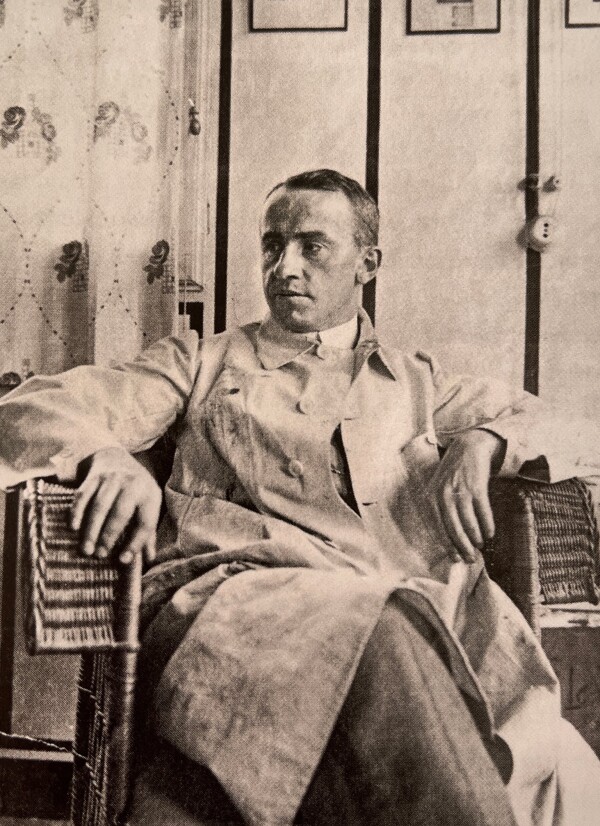
Leopold Forstner in a painter's smock, around 1910
© Artist's estate Leopold Forstner
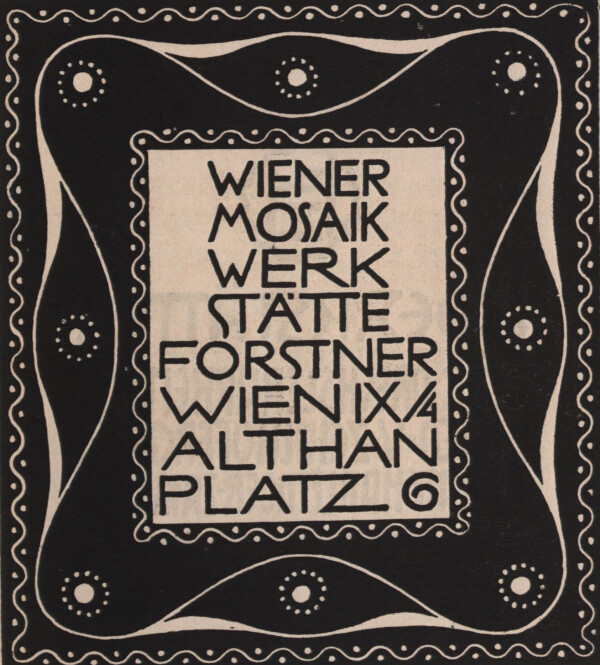
Advertisement for the Viennese mosaic workshop by Leopold Forstner, 1908
© Klimt Foundation, Vienna
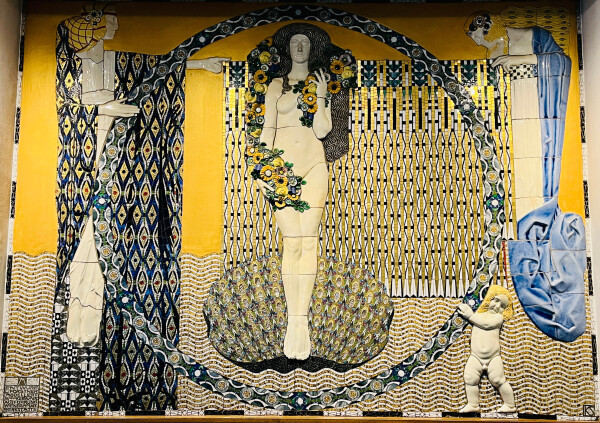
Leopold Forstner: Mosaic Spring in the dining room of the Grand Hotel Wiesler in Graz, 1909
© Klimt Foundation, Vienna

Leopold Forstner: Poster for the exhibition Das moderne Bureau, Vienna, 1909
© Staatliche Museen zu Berlin, Kunstbibliothek
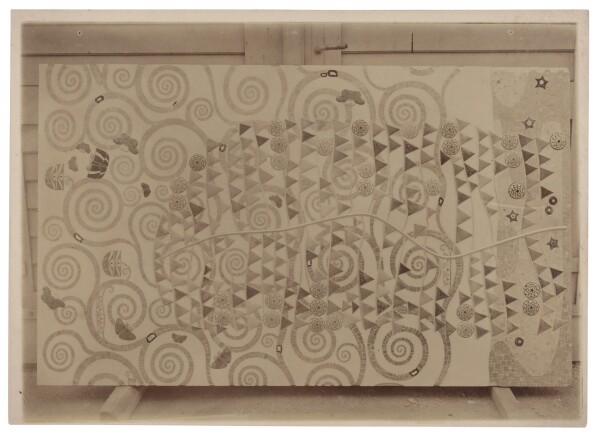
Moriz Nähr (?): The Stoclet frieze (rose bush), October 1911, Klimt Foundation
© Klimt Foundation, Vienna
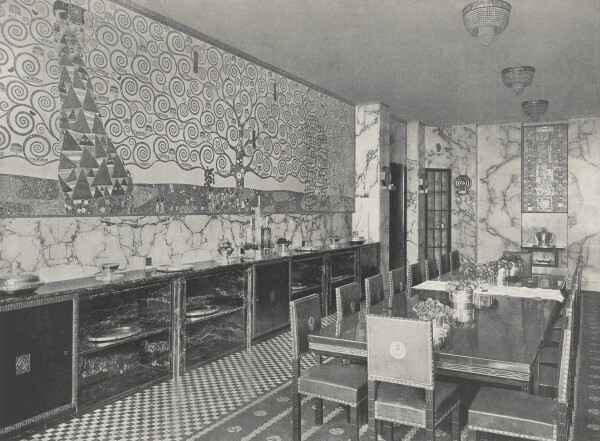
Insight into the Palais Stoclet, circa 1914
© Klimt Foundation, Vienna
The Universalkünstler [universal artist] Leopold Forstner was best known for his craft art. He always worked independently, yet collaborated closely with the artistic collectives of his time, creating flawlessly elegant works. His mosaic workshop Wiener Mosaikwerkstätte was responsible for the execution of Klimt’s Stoclet Frieze.
“Brittle Invention Paired with Artistic Gravity.” Forstner’s Training Years
Leopold Forstner was born in Bad Leonfelden, Upper Austria, on 2 November 1878. After his training at the State School of Crafts in Linz and the Tyrolean School of Glass Painting in Innsbruck, he studied at the Imperial-Royal School of Arts and Crafts from the winter semester of 1898/99. He studied first with Karl Karger, but joined Kolo Moser’s class after one year. From November 1902, Forstner continued his studies at the Munich Academy of Fine Arts. In 1903, he traveled to Venice, Ravenna and Rome. These trips played a major role in awakening his interest for craft art. Gustav Klimt also visited Venice and Ravenna the same year and was deeply impressed by the mosaics he saw there.
Forstner’s Exhibition Debut
It was especially through Moser that Forstner met important figures. In 1902, he participated in the “XV. Ausstellung der Vereinigung Bildender Künstler Österreichs Secession” [“15th Exhibition of the Association of Austrian Artists Vienna Secession”]. The following year, he contributed woodcuts for Ver Sacrum. In 1904, Forstner received one of his first commissions even before the official founding of his own workshop: the execution of the store sign for the “Schwestern Flöge” fashion salon, designed by the Wiener Werkstätte. In 1908, he presented poster designs, a painting and a large selection of mosaic works at the “Kunstschau Wien.” Room 25 was reserved for Forstner and his mosaic workshop, which had been officially founded that year. His skills were unanimously praised by the critics. Joseph August Lux, for instance, declared:
“Sometimes, [youth] even summons its strength to go beyond mere improvisation and implement a serious life program. This is how I see young Leopold Forstner, who, already reputed as a painter and illustrator, has turned exclusively to craft art and has opened his own mosaic workshop.”
In 1909, Forstner was again invited to participate in the “Internationale Kunstschau,” where he exhibited several of his works, for instance a fragment of the mosaic Spring, which he executed in the dining room of the Grand Hotel Wiesler in Graz the same year. Two years later, in 1911, he gave his exhibition debut abroad at the “Internationale Kunstausstellung” [“International Art Exhibition”] in Rome. In the same exhibition, Klimt presented eight paintings, winning a cash prize.
“Not in the Fresco […], but in the Mosaic Lies the Future.” The Wiener Mosaikwerkstätte
The business license gives 25 February 1908 as the official date of foundation for the Wiener Mosaikwerkstätte. In his mosaic workshop, Forstner took the double role of artist and artisan. The first studio was located at Althanplatz 6 (Vienna-Alsergrund, 9th District). With his workshop, Forstner consolidated his reputation as a craft artist, executing designs by other artists as well as his own designs. Constantly searching for new ways in mosaic art, Forstner specialized in designs that combined various materials – from glass elements and ceramics to gemstones and precious metals. Inspired by Otto Wagner, he established the Plattenmosaik, a mosaic technique that would also be used in Klimt’s Stoclet Frieze (1905–1911, privately owned).
One of his first major commissions was the execution of Moser’s designs for leaded glass windows for the Church at Steinhof built by Wagner (1904–1907). The mosaic The Promise of Heaven (1912) for the main altar was eventually also designed and executed by Forstner, after Moser had initially been commissioned with the work.
In 1910, Forstner moved to a larger workshop area at Pappenheimgasse 41 (Wien-Brigittenau, 20th District) – probably also because of the planned execution of the mosaic frieze in Brussels, which began in August of the same year.
“Who Will Give the Artist a Similar Commission for Vienna?” Klimt, Forstner and Stoclet Palace in Brussels
The unique artistic feat of which Klimt said he was “as sick […] as I am of the abscess on my neck” was executed in collaboration with the following companies: The marble company Oreste A. Bastreri, which frequently collaborated with the Wiener Werkstätte, provided the marble plates. The Wiener Keramik workshop was responsible for the ceramic details. The Wiener Werkstätte produced the metal parts and the enamel class of the Vienna School of Arts and Crafts created the necessary enamel components. Forstner’s mosaic workshop was in charge of executing the design and combining all these individual parts in a so-called Plattenmosaik, “a work that requires the greatest precision and presents substantial difficulties,” as Josef Folnesics, assistant director of the Austrian Museum of Art and Industry (now MAK – Museum of Applied Arts, Vienna) explained.
Klimt added many notes and instructions for the executing team to his design drawings and was himself involved in the execution. The first samples he was given to inspect were little convincing and he demanded changes. Several gold samples had to be made to find the right shade of gold for the mosaic, as Berta Zuckerkandl recalled. Klimt was never fully satisfied, even after the work had been completed.
Presentation in Vienna
While Berta Zuckerkandl related in the Allgemeine Wiener Zeitung on 23 October 1911 that a small, illustrious group had been allowed to see the frieze at Forstner’s mosaic workshop before it was transported to Brussels, Roessler reported a few days later in the Arbeiter-Zeitung: “A new work by Gustav Klimt can currently be viewed at L. Forstner’s mosaic workshop, 20th District Pappenheimgasse 41: part of the wall paneling for a room in the Stoclet villa built by Professor Hoffmann in Brussels.” It seems that the work was not presented publicly in an official exhibition. Nevertheless, the Viennese society was given the opportunity to view parts of the frieze. Waerndorfer obtained Adolphe Stoclet’s consent in advance. It was probably in this context that Moriz Nähr photographed the panels.
The long process of transporting the work to Brussels began in November. Klimt’s Stoclet Frieze arrived in early December. In early 1912, Forstner came to Belgium to complete the final works on location. Apart from the mosaic for the dining room he also created a glass-and-ceramics mosaic in the vestibule of the palace and executed mosaics of fish, which were intended for the bathroom.
In 1912, Forstner presented some of his works at the “Frühjahrsausstellung” [“Spring Exhibition”] of the Imperial-Royal Austrian Museum of Art and Industry. The exhibition also showcased Stoclet Palace and the artistic team involved in the creation of this Gesamtkunstwerk, for instance presenting Klimt’s design drawings for The Stoclet Frieze. Neither the exhibition nor the catalogue mentioned Forstner’s role in the execution. The Wiener Reichspost observed:
“The group of collaborators would not be complete without mentioning Leopold Forstner, who is not named as a collaborator in the catalogue, but who gave Klimt’s marble frieze design its fascinating liveliness with the ingenious translation into the materials of mosaic, majolica, metal enamel.”
“Lawsuit Concerning a Mosaic after Klimt.” Forstner’s Demand for Artistic Recognition
Forstner received a fee of 14,000 crowns (about 87,000 euros) from the Wiener Werkstätte for his work on the frieze. He demanded an additional payment, however, as a proportionate compensation for his artistic input in the execution of the work. When the Wiener Werkstätte refused to make any additional payments, Forstner filed a lawsuit. A hearing was held on 30 August 1912 but brought no solution. The panel of the civil court decided to adjourn the proceedings and summoned Moser as an expert witness who was to “testify to the plaintiff’s artistic value.” A few weeks later, Forstner withdrew the complaint without making any further demands.
Forstner’s Life after The Stoclet Frieze
Forstner moved to Stockerau, the birthplace of his wife Stefanie Stöger, in 1915. Shortly thereafter he traveled through the occupied Balkan regions as a monuments officer for the Imperial-Royal Military Museum. These trips are reflected in several drawings. After the end of the War, Forstner abandoned his mosaic workshop and turned to the creation and decoration of precious glassware. From 1929 until his death he taught at the local secondary school Bundesrealgymnasium Hollabrunn and worked in various fields of arts and crafts. Forstner died on 5 November 1936 and was laid to rest at the cemetery in Stockerau in a family grave he had designed himself.
Literature and sources
- Josef August Lux: Kunstschau Wien 1908, in: Deutsche Kunst und Dekoration, Band 23 (1908/09), S. 33-61, S. 51.
- Berta Zuckerkandl: Eine Wiener Mosaik-Werkstätte, in: Deutsche Kunst und Dekoration, Band 24 (1909), S. 85-90, S. 85, S. 87.
- Ansichtskarte von Gustav Klimt in Wien an Emilie Flöge in Kammer am Attersee, 2. Karte (Morgen) (07/21/1910). RL 2822, .
- Franz Servaes: Ein Streifzug durch die Wiener Malerei, in: Kunst und Künstler. Illustrierte Monatsschrift für bildende Kunst und Kunstgewerbe, 8. Jg., Heft 12 (1910), S. 587-598, S. 593.
- Leopold Forstner: Mosaik, Glasmalerei und Mosaikverglasung. Gedanken eines Praktikers, in: Deutsche Kunst und Dekoration, Band 27 (1910/11), S. 383-286.
- Berta Zuckerkandl: Der Klimt-Fries, in: Wiener Allgemeine Zeitung, 23.10.1911, S. 2.
- Arthur Roessler: Theater und Kunst. Wiener Mosaikwerkstätte, in: Arbeiter-Zeitung (Morgenausgabe), 29.10.1911, S. 11.
- N. N.: Prozess um ein Mosaikfries nach Klimt, in: Neues Wiener Tagblatt, 01.09.1912, S. 17.
- N. N.: Eine Klage gegen die Wiener Werkstätte, in: Neues Wiener Journal, 01.09.1912, S. 15f..
- N. N.: Der Mosaikfries Gustav Klimts, in: Die Zeit, 02.10.1912, S. 6.
- Amalie Sara Levetus: Das Stoclethaus zu Brüssel von Architekt Josef Hoffmann, in: Moderne Bauformen. Monatshefte für Architektur und Raumkunst, 13. Jg. (1914), S. 1-34.
- N. N.: Stockerau. Ein neuer Mitbürger, in: Österreichische Land-Zeitung, 12.06.1915, S. 17.
- Wilhelm Mrazek: Die Mosaikwerkstätte Leopold Forstner-Wien, in: Leopold Forstner. Ein Maler und Materialkünstler des Wiener Jugendstils, Vienna 1981.
- Josef Folnesics: Die Mosaikwerkstätte L. Forstner, in: Zeitschrift für alte und neue Glasmalerei und verwandte Gebiete, Heft 4 (1912), S. 38.
- Ludwig Hevesi: Aus dem Wiener Kunstleben. Kunstschau, in: Kunst und Kunsthandwerk. Monatsschrift des k. k. Österreichischen Museums für Kunst und Industrie, 12. Jg., Heft 5 (1909), S. 295.
- Arthur Roessler: Leopold Forstners Hochaltarmosaik in der Kirche Am Steinhof in Wien, in: Moderne Bauformen. Monatshefte für Architektur und Raumkunst, 13. Jg. (1914), S. 381-383.

